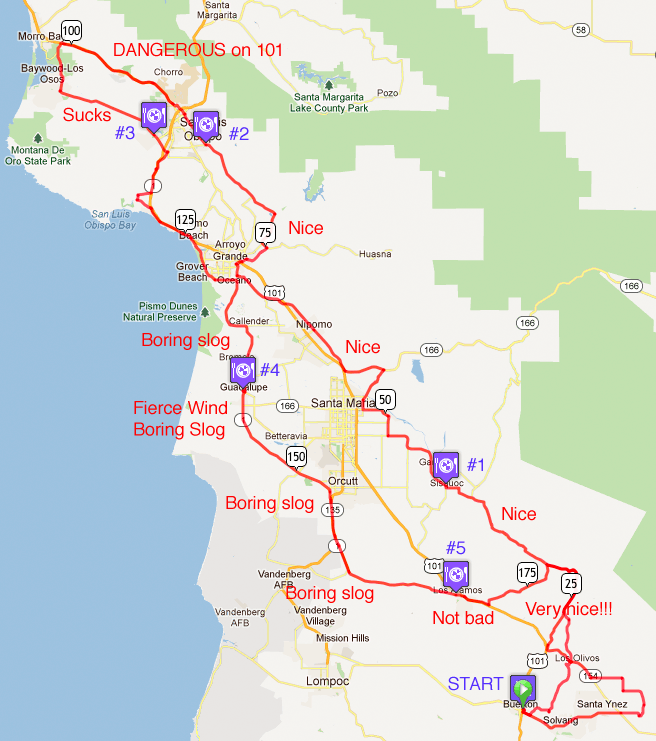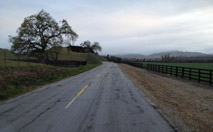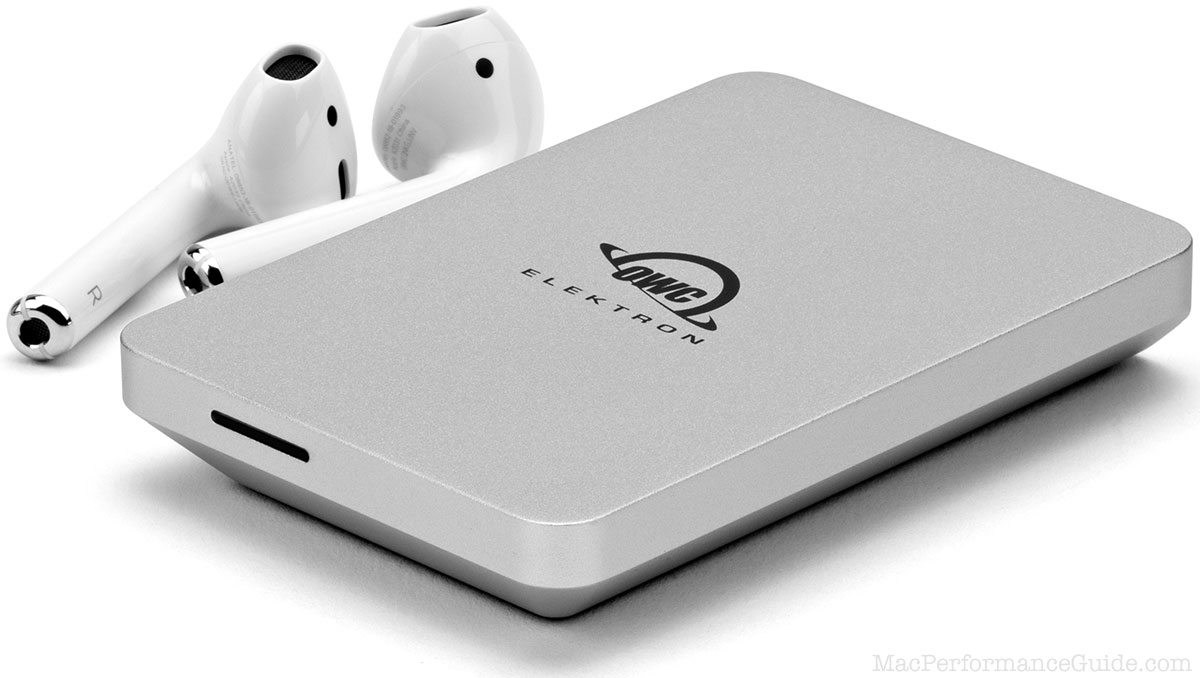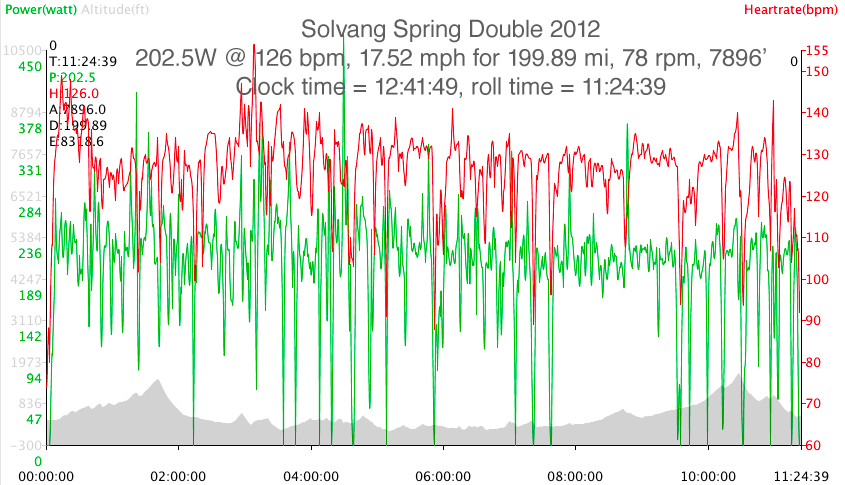
$220 SAVE $130 = 37.0% Western Digital 16.0TB Western Digital Ultrastar DC HC550 3.5-in… in Storage: Hard Drives
|

|

|

|

|
Solvang Spring Double Century
Related: double century, exercise, hard core, heart rate, Lightweight, Moots, Rides, tubular, ultra endurance exercise
See the official Solvang Double Century details at planetultra.com and/or the RideWithGPS.com turn-by-turn map.
I rode the Solvang Spring Double on my Moots Vamoots RSL with the Lightweight Obermayer rear wheel and Lightweight VR8 front wheel, and using the SRM Cannondale Hollowgram SL power meter. I can’t praise the Moots or the wheels enough, and I had repeated compliments of “nice Moots!!!” at every stop.
Riders
Glancing around at registration, I noted that riders were dominated by 40-60 year old men. No younger men, and very few women. The faces showed a hard-core serious crowd. It was quite interesting, and very different from many events I’ve participated in.
The results confirm this as highly accurate. It’s humbling to be beaten by a lot of guys in their 50’s and even some in their 60’s! (I was 47 at the time of the race).
Quality miles but too many ugly miles
I’d say that half the miles were enjoyable, but there were at least 100 miles of road that ranged from downright dangerous (US 101), to a long boring slog.
Overall, I much preferred the Death Valley Double, with its nearly turn-free course and very few but exceptionally courteous drivers on sparsely driven roads.
The Solvang Double is worth doing once, but I’d rate it as much less enjoyable than the Everest Challenge or the Death Valley Double— at least in spring.
Solvang has ample road hazards, dirt and debris on some road shoulders, at least a few callously dangerous drivers and it fails to reward the rider for over half its mileage. For too many of the miles, one had to be alert to traffic or other road conditions. And way too frequent broken glass (near Morro Bay) is a real turn-off.

First 80 miles — gracious hills
The first ~80 miles were very enjoyable riding, climbing eastward into the hills and then heading north to rest stop #2 just shy of San Luis Obispo.
For 30 miles or so, I enjoyed a conversation with a fast rider on a recumbent bicycle, which proved to me just how aerodynamic a recumbent is compared to a road bike! There was simply no way to match speed downhill, even pedaling at 300 watts I could barely keep up on moderately steep downhill grades.

The fast pack
At mile ~56, I jumped onto a very fast moving pack, hitting speeds of 30 mph or greater. At the rear, I was having to surge from 300 to 500 watts just to stay on the back, though I also had some coasting time as well; very erratic demands.
I rarely ride in packs, but I thought it would be a worthwhile learning experience, as it was, but for reasons I had not expected.
The pack was hammering hard, oblivious to road hazards to those towards the rear (and making no motions to indicate hazards). I was aware of this, and when my wheels hit some nasty pavement hard I concentrated even more on watching for road hazards, but instant reflexes I do not have.
Around mile ~61, without warning my front wheel slammed hard into a deep pavement divot, instantly pinch-flatting my front tubular tire. It’s not easy to pinch flat a tubular (never happened in 7 years of riding tubulars), but the impact was so severe that I was at first concerned that the Lightweight VR8 wheel was damaged, but it was not. But the beauty of tubulars is that even badly damaged, they don’t deflate instantly (a few seconds elapse), and just as important for carbon rims, they protect the rim as they flatten over it.
I coasted to a stop, and started peeling off the tire, mounting a pre-glued spare. From then on, the tire was attached only air pressure (the pre-glue has some binding effect, but it is not safe to do hard cornering). The same rider on a recumbent was kind enough to stop and provide a CO2 cartridge, which inflated the spare tire nicely. I was ready to roll. Except that the brand-new spare quickly picked up a fast leak, good for losing 40 psi every hour or so (pinhole leaks are often caused by tiny wires from worn-out tires). And so too did my rear tire, though it was 40 psi every 2-3 hours. Such would be the rest of the day, inflating to full pressure at each stop, with higher and higher rolling resistance as the tires lost pressure.
San Luis Obispo
I stopped at Foothill Cyclery, a well-stocked bike shop. It was a modest detour. I picked up a spare tubular tire, a valve extender for it, a valve removal tool and pump and CO2 (all of which I had stupidly forgotten!). Because I was darn sure not going to sag back if I had another flat. It was worth the time to stop.
Together with the detour and the time in the shop, this was a 25 minute delay (on top of the 7-8 minute delay to peel and replace the flat tire). But I did not want to ride 110 miles having no spare tire, now that my only spare had been used. I made a mental note to always carry at least two spares on a Double Century. My advice is that even riders using clincher tires should carry not just spare tubes, but a spare tire also, a lightweight foldable one for easy carry.
I debated stopping to put some Stan’s NoTubes into my tires, and this in hindsight would have been a wise action. But as of San Luis Obispo, it was not yet clear how fast the air was leaking. As it turns out, the Stans NoTubes was highly effective with the leaky front tire post-ride, so much so that I went ahead and glued it onto the Lightweight VR8 wheel for further use. Good stuff. For future double centuries, I will likely use 1/2 tube of Stans NoTubes in advance, which kills off any pinhole leaks picked up along the way.
It was in San Luis Obispo riding from the bike shop (off the route) that the asshole-driver count increased to three: a BMW raced ahead, hit the brakes hard and did a sharp right turn in front of me. That followed two vehicles earlier that day which gave me ~2 feet of clearance doing 60+ mph. May they get what they deserve, some day.
Ultra-high performance across entire capacity, outperforms the competition.
Tiny, bus-powered, rugged, compact!
Morro Bay area
The mileage through the Morro Bay area was awful— 10 miles or so on US 101 with traffic going by at 65-80 mph. In that section, you take your life into your hands passing another rider (which I had to do several times), unless you want to pass on the right into the debris. Look, look again, look again, then pass.
Leaving the freeway towards the coast, there are some miles of gritty pavement awash with light gravel and broken glass and a few miles of extremely rough shoulder. One then arrives at the 3rd aid station.
Pismo Beach area
There is a very nice view of the sunlit ocean in Pismo Beach, but it is brief, and one must constantly pay attention to traffic and there a number of turns and stop signs.
Guadalupe area
This area is a very long slog. Flat and boring, with farm fields consisting of mostly bare dirt and straight into a 25-40 mph gale (in 2012).
For a very long distance in the Guadalupe area, riding was straight into an unrelenting wind of 25 mph or so, perhaps gusting 40 mph. Pushing 220 watts into the pedals on pancake-flat roads was rewarded with speeds of 11-13 mph. It did not help to have my front tire with its slow leak dropping towards 30 psi, and the rear approaching 80 psi.
At 175 pounds, I am no lightweight, and sustaining power into wind was not easy either physically or psychologically. On flat ground, it’s absolute power that counts (not power to weight), and thus lighter or less strong riders were doing perhaps 7-9 mph— I passed many of them, some of them huddled in groups like forlorn sheep. Only approaching Los Alamos did some relief finally come as the road changed direction relative to the wind.
Los Alamos aid station
Approaching and beyond Los Alamos, the riding becomes pleasant again, though as one is well fatigued by this point, it was less easy to appreciate. I forgot to inflate my tires here, so I turned around and took care of it (another 5 minutes wasted), the front was at ~25 psi, and the rear at ~80 psi.
Leaving Los Alamos, there is one detour section along the freeway with pavement more suitable for a mountain bike than anything else. It was rough, really rough, but fortunately it lasted only 1/4 mile or so, before climbing a gentle grade for the last climb of the day towards the highway and then Foxen Canyon road.
Finishing
As I turned right from Foxen Canyon Road with a mile to the finish, I stood up to accelerate, and was rewarded with a dizzy feeling. Well, it was a double century! I was glad to be done.
Ride Analysis with power and heart rate
Please click the graph to read more.
Solvang Spring Double Century, March 21 2015
Aside from a few badly timed stoplights, nothing untoward. No flats (first time in 3 efforts!), which was sheer luck since never in any event have I seen so many people with so many flat tires. The junk-miles portions of the course are littered with glass on some sections, with constant vigilance required. Dangerous drivers near Pismo Beach in heavy traffic cut me off three times; extreme caution is needed. I heard similar stories from other riders.
I was able to maintain good power the entire ride and even finish stronger than ever. I attribute this to a 245 calorie/hour intake of Hammer Nutrition HEED, Hammer Perpetuem solids, GU gels, and some junk candy (black licorice, two mini candy bars, 5 sticks of red vines, one small pack gummies). For me at least, gels and HEED just don’t do it fully (these are almost entirely maltodextrin); the liver should not remain idle; it has a job to do, so scarfing some sucrose and fructose at mile 80 on up at it keeps it active, converting about 60 calories/hour of those sugars into glucose—very significant in context of overall fueling intake of 245 calories/hour (which is about the limit of what the stomach can process during such an event, assuming good hydration).
This was a solo time trial (ZERO drafting though I sometimes “pull” others). Nearly all riders with faster times were pacelining (one fast group that went by had 7 or 8 riders, making it a hugely easier effort 80% of the time for all the riders). Thus their times are not comparable; a different event in the reality of actual performance (a great deal of resting/coasting!). And some riders consistently blow through stop signs and lights (*that* is outright cheating, and illegal too). I do not wish to “win” by someone else’s wind-blocking exertions, and certainly not by cheating. In a RACE, yes I *will* draft (within my racing category), since that is part of the race strategy and cannot be set aside in a race.
Solvang Spring Double 2015 results. Total clock time for me includes some bad luck with stop lights and stop signs (traffic), and some route verification.
Kilojoules: 7517

Seagate 22TB IronWolf Pro 7200 rpm SATA III 3.5" Internal NAS HDD (CMR)
SAVE $100





